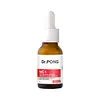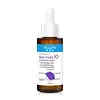What's inside
What's inside
 Key Ingredients
Key Ingredients

 Benefits
Benefits

 Concerns
Concerns

 Ingredients Side-by-side
Ingredients Side-by-side

Water
Skin ConditioningGlycerin
HumectantBiosaccharide Gum-1
HumectantHydroxyethylcellulose
Emulsion StabilisingHydroxypropyl Guar
Emulsion StabilisingNiacinamide
SmoothingHydroxyethyl Urea
HumectantSilanediol Salicylate
EmollientTranexamic Acid
AstringentAcetyl Tyrosine
Skin ConditioningCaprylic/Capric Triglyceride
MaskingHydrogenated Lecithin
EmulsifyingPhytosteryl/Octyldodecyl Lauroyl Glutamate
Skin ConditioningCeramide NP
Skin ConditioningSodium Hyaluronate
HumectantCaprylyl Glycol
EmollientAcetyl Tetrapeptide-2
Skin ConditioningButylene Glycol
HumectantGlycine Soja Seed Extract
Skin ConditioningPolyacrylate Crosspolymer-6
Emulsion StabilisingGlycogen
HumectantMannitol
HumectantPhosphatidylcholine
EmulsifyingCholesterol
EmollientXanthan Gum
EmulsifyingSodium Chloride
MaskingTocopheryl Acetate
AntioxidantLactic Acid/Glycolic Acid Copolymer
Skin ConditioningPolyvinyl Alcohol
Arbutin
AntioxidantSodium Ascorbyl Phosphate
AntioxidantPalmitoyl Sh-Tripeptide-5 Norisoleucyl Sh-Nonapeptide-1
Skin ConditioningLinolenic Acid
CleansingHydroxyacetophenone
AntioxidantDipropylene Glycol
HumectantDipotassium Glycyrrhizate
HumectantWater, Glycerin, Biosaccharide Gum-1, Hydroxyethylcellulose, Hydroxypropyl Guar, Niacinamide, Hydroxyethyl Urea, Silanediol Salicylate, Tranexamic Acid, Acetyl Tyrosine, Caprylic/Capric Triglyceride, Hydrogenated Lecithin, Phytosteryl/Octyldodecyl Lauroyl Glutamate, Ceramide NP, Sodium Hyaluronate, Caprylyl Glycol, Acetyl Tetrapeptide-2, Butylene Glycol, Glycine Soja Seed Extract, Polyacrylate Crosspolymer-6, Glycogen, Mannitol, Phosphatidylcholine, Cholesterol, Xanthan Gum, Sodium Chloride, Tocopheryl Acetate, Lactic Acid/Glycolic Acid Copolymer, Polyvinyl Alcohol, Arbutin, Sodium Ascorbyl Phosphate, Palmitoyl Sh-Tripeptide-5 Norisoleucyl Sh-Nonapeptide-1, Linolenic Acid, Hydroxyacetophenone, Dipropylene Glycol, Dipotassium Glycyrrhizate
Water
Skin ConditioningIsopentyldiol
HumectantPropanediol
SolventPentylene Glycol
Skin ConditioningTranexamic Acid
AstringentNiacinamide
SmoothingPhenoxyethanol
PreservativeXanthan Gum
EmulsifyingGlycerin
HumectantEthylhexyl Palmitate
EmollientGlycolic Acid
BufferingSodium Hydroxide
BufferingPolysorbate 80
EmulsifyingPhospholipids
Skin ConditioningDipropylene Glycol
HumectantBiosaccharide Gum-1
HumectantLactic Acid
BufferingSodium Magnesium Silicate
Citric Acid
BufferingDipotassium Glycyrrhizate
HumectantEthylhexylglycerin
Skin Conditioning1-Methylhydantoin-2-Imide
Skin ConditioningTocopheryl Acetate
AntioxidantCholesterol
EmollientHydroxypropyl Guar
Emulsion StabilisingHydroxybutyl Methylcellulose
Emulsion StabilisingDisodium EDTA
Hyaluronic Acid/Polyisopropylacrylamide Copolymer
HumectantGeranium Robertianum Extract
AstringentScutellaria Baicalensis Root Extract
AstringentHouttuynia Cordata Extract
Skin ConditioningCitrus Reticulata Peel Extract
Skin ConditioningAlgae Extract
EmollientCentaurea Cyanus Flower Extract
AstringentAspalathus Linearis Extract
Skin ConditioningPhaseolus Radiatus Sprout Extract
HumectantWater, Isopentyldiol, Propanediol, Pentylene Glycol, Tranexamic Acid, Niacinamide, Phenoxyethanol, Xanthan Gum, Glycerin, Ethylhexyl Palmitate, Glycolic Acid, Sodium Hydroxide, Polysorbate 80, Phospholipids, Dipropylene Glycol, Biosaccharide Gum-1, Lactic Acid, Sodium Magnesium Silicate, Citric Acid, Dipotassium Glycyrrhizate, Ethylhexylglycerin, 1-Methylhydantoin-2-Imide, Tocopheryl Acetate, Cholesterol, Hydroxypropyl Guar, Hydroxybutyl Methylcellulose, Disodium EDTA, Hyaluronic Acid/Polyisopropylacrylamide Copolymer, Geranium Robertianum Extract, Scutellaria Baicalensis Root Extract, Houttuynia Cordata Extract, Citrus Reticulata Peel Extract, Algae Extract, Centaurea Cyanus Flower Extract, Aspalathus Linearis Extract, Phaseolus Radiatus Sprout Extract
Ingredients Explained
These ingredients are found in both products.
Ingredients higher up in an ingredient list are typically present in a larger amount.
Biosaccharide Gum-1 is a sugar created by fermenting sorbitol (which usually comes from potato starch!). It is known for its soothing and moisturizing properties.
Manufacturer tests show this ingredient helped reduce irritation from lactic acid by almost half and kept skin hydrated long-term as a humectant
Beyond hydration, Biosaccharide Gum-1 gives formulas a silky, non-sticky feel.
This ingredient is gentle, versatile, and suitable for all skin types.
Fun fact: Similar sugars can be found naturally in fruits like apples and pears.
Learn more about Biosaccharide Gum-1Cholesterol is a class of organic molecules called lipids. It helps hydrate your skin and is essential to having a healthy skin barrier.
Our skin naturally contains cholesterol in the outermost layer. Besides cholesterol, it also contains ceramides and fatty acids. Cholesterol makes up about 1/4 of your skin's outer layer and barrier. Your skin barrier is responsible for keeping allergens and microbes out. Having a healthy skin barrier is also responsible for keeping your skin firm and plump.
Our bodies use cholestrol to create vitamin D, steroid hormones, and more.
Learn more about CholesterolDipotassium Glycyrrhizate comes from licorice root.
Extracts of licorice have demonstrated to have antibacterial, anti‐inflammatory, antiviral, antioxidant properties.
One component, glabridin, has extra potent antioxidant and soothing properties. It has also been found to block pigmentation from UVB rays in guinea pigs.
Licorice Root also contains a flavonoid. Flavonoids are a natural substance from in plants. Flavonoids also have antioxidant properties.
Another component, glycyrrhizin, has been found to have anti-inflammatory and antimicrobial benefits. This may make licorice root extract effective at treating acne. However, more research is needed to support this.
Liquiritin is one of the flavone compounds found in licorice. It has been found to help lighten skin by preventing tyrosinase from reacting with tyrosine. When the two react, protein is converted to melanin. Melanin is the substance in your body that gives your features pigmentation.
Licorice root is native to Southern Europe and Asia. It has been used in traditional Chinese medicine to help with respiratory issues.
Learn more about Dipotassium GlycyrrhizateDipropylene Glycol is a synthetically created humectant, stabilizer, and solvent.
This ingredient helps:
Dipropylene glycol is technically an alcohol, but it belongs to the glycol family (often considered part of the ‘good’ alcohols). This means it is hydrating and gentle on skin unlike drying solvent alcohols like denatured alcohol.
As a masking agent, Dipropylene Glycol can be used to cover the smell of other ingredients. However, it does not have a scent.
Studies show Dipropylene Glycol is considered safe to use in skincare.
Learn more about Dipropylene GlycolGlycerin is already naturally found in your skin. It helps moisturize and protect your skin.
A study from 2016 found glycerin to be more effective as a humectant than AHAs and hyaluronic acid.
As a humectant, it helps the skin stay hydrated by pulling moisture to your skin. The low molecular weight of glycerin allows it to pull moisture into the deeper layers of your skin.
Hydrated skin improves your skin barrier; Your skin barrier helps protect against irritants and bacteria.
Glycerin has also been found to have antimicrobial and antiviral properties. Due to these properties, glycerin is often used in wound and burn treatments.
In cosmetics, glycerin is usually derived from plants such as soybean or palm. However, it can also be sourced from animals, such as tallow or animal fat.
This ingredient is organic, colorless, odorless, and non-toxic.
Glycerin is the name for this ingredient in American English. British English uses Glycerol/Glycerine.
Learn more about GlycerinWe don't have a description for Hydroxypropyl Guar yet.
Niacinamide is a multitasking form of vitamin B3 that strengthens the skin barrier, reduces pores and dark spots, regulates oil, and improves signs of aging.
And the best part? It's gentle and well-tolerated by most skin types, including sensitive and reactive skin.
You might have heard of "niacin flush", or the reddening of skin that causes itchiness. Niacinamide has not been found to cause this.
In very rare cases, some individuals may not be able to tolerate niacinamide at all or experience an allergic reaction to it.
If you are experiencing flaking, irritation, and dryness with this ingredient, be sure to double check all your products as this ingredient can be found in all categories of skincare.
When incorporating niacinamide into your routine, look out for concentration amounts. Typically, 5% niacinamide provides benefits such as fading dark spots. However, if you have sensitive skin, it is better to begin with a smaller concentration.
When you apply niacinamide to your skin, your body converts it into nicotinamide adenine dinucleotide (NAD). NAD is an essential coenzyme that is already found in your cells as "fuel" and powers countless biological processes.
In your skin, NAD helps repair cell damage, produce new healthy cells, support collagen production, strengthen the skin barrier, and fight environmental stressors (like UV and pollution).
Our natural NAD levels start to decline with age, leading to slower skin repair, visible aging, and a weaker skin barrier. By providing your skin niacinamide, you're recharging your skin's NAD levels. This leads to stronger, healthier, and younger looking skin.
Another name for vitamin B3 is nicotinamide. This vitamin is water-soluble and our bodies don't store it. We obtain Vitamin B3 from either food or skincare. Meat, fish, wheat, yeast, and leafy greens contain vitamin B3.
The type of niacinamide used in skincare is synthetically created.
Learn more about NiacinamideTocopheryl Acetate is AKA Vitamin E. It is an antioxidant and protects your skin from free radicals. Free radicals damage the skin by breaking down collagen.
One study found using Tocopheryl Acetate with Vitamin C decreased the number of sunburned cells.
Tocopheryl Acetate is commonly found in both skincare and dietary supplements.
Learn more about Tocopheryl AcetateTranexamic Acid is best used for treating hyperpigmentation, discoloration, and melasma. It can also help build a stronger skin barrier.
Once applied, Tranexamic Acid starts decreasing inflammation from UV exposure. Tranexamic Acid also prevents our skin cells from meeting the pigment production cells.
Its brightening property makes it great at reducing the appearance of acne scars and marks.
Fun fact: Tranexamic Acid is also a medication used to reduce heavy bleeding.
This acid is derived from lysine, an amino acid.
Learn more about Tranexamic AcidWater. It's the most common cosmetic ingredient of all. You'll usually see it at the top of ingredient lists, meaning that it makes up the largest part of the product.
So why is it so popular? Water most often acts as a solvent - this means that it helps dissolve other ingredients into the formulation.
You'll also recognize water as that liquid we all need to stay alive. If you see this, drink a glass of water. Stay hydrated!
Learn more about WaterXanthan gum is used as a stabilizer and thickener within cosmetic products. It helps give products a sticky, thick feeling - preventing them from being too runny.
On the technical side of things, xanthan gum is a polysaccharide - a combination consisting of multiple sugar molecules bonded together.
Xanthan gum is a pretty common and great ingredient. It is a natural, non-toxic, non-irritating ingredient that is also commonly used in food products.
Learn more about Xanthan Gum